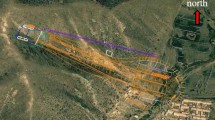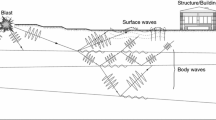Abstract
This paper describes measurement and interpretation of strains induced in two, multiple story, older, urban structures by ultra-high frequency rock blast excitation from contiguous excavation. These strains are obtained from relative displacements found by integrating time correlated velocity time histories from multiple positions on the structures and foundation rock. Observations are based on ten instrumented positions on the structures and in the foundation rock during eight blast events, which provided over 70 time histories for analysis. The case study and measurements allowed the following conclusions: despite particle velocities in the rock that greatly exceed regulatory limits, strains in external walls are similar to or lower than those necessary to crack masonry structures and weak wall covering materials. These strains are also lower than those sustained by single story residential structures when excited by low frequency motions with particle velocities below regulatory limits. Expected relative displacements calculated with pseudo velocity single degree of freedom response spectra of excitation motions measured in the rock are similar to those measured.










Similar content being viewed by others
References
Abeel PA (2012) Building and crack response to blasting, construction vibrations and weather effects. Master of Science thesis, Northwestern University, p 114
Aimone-Martin CT, Meins BM (2014) Tall structure response to close-in blasting in New York City—a comparison with residential structure response. In: 40th annual conference on explosives and blasting techniques. International Society of Explosives Engineers, Cleveland
Aimone-Martin C, Meins B, Lauer J, Brent R (2014) Tall structure response to close-in urban blasting in New York City. J Explos Eng 31(4):6–18, 38
Deutsches Institut für Normung (DIN) (1986) Vibrations on building construction, Part 3-Effects on structures. DIN 4150-3, Berlin
Dowding CH (2000) Construction vibrations. Available through Amazon, 1996 version. Prentice Hall, New Jersey, p 620
Dowding CH, McKenna LM (2005) Crack response to long-term environmental and blast vibrations effects. ASCE J Geotech Geoenviron Eng 131(9):1151–1161
Hamdi E (2015) Analysis of urban buildings response to close-in blasting induced vibrations. Fulbright Visiting Research Scholar Program report. Department of Civil and Environmental Engineering, Northwestern University, Evanston, 79 pages
Oriard LL (1972) Blasting effects and their control in open pit mine. In: Brawner CO, Milligan V (eds) Proceedings of second international conference on stability in open pit mining. ASME-AIME, Littleton, pp 197–222
Panish PT (1992) The Mt. prospect region of western Connecticut; mafic plutonism in Iapetus-sequence strata and thrust emplacement onto the North American margin. In: Robinson P, Brady JB (eds) Guidebook for field trips in the Connecticut Valley region of Massachusetts and adjacent states, vol 2. University of Massachusetts, Geology Department contribution, no. 66, New England Intercollegiate geological conference, 84th annual meeting, Amherst, 9–11 Oct 1992, pp 398–423
Rosenhaim VL, Aimone-Martin CT, Munaretti E, Koppe JC (2014) Structure and crack response to coal and quarry blasting in Brazil. In: 40th annual conference on explosives and blasting techniques. International Society of Explosives Engineers, Cleveland
Siskind DE (2000) Vibrations from blasting. International Society of Explosive Engineers, Cleveland, 120 pages
Siskind DE, Stagg MS, Kopp JW, Dowding CH (1980) Structure response and damage produced by ground vibration from surface mine blasting. US Bureau of Mines, RI 8507
Woods R, Jedele J (1985) Energy-attenuation relationships from construction vibrations. In: Gazetas G, Selig ET (eds) Vibration problems in geotechnical engineering. Special Technical Publication, ASCE, New York, pp 187–202
Acknowledgments
This paper is the result of an unusual set of fortuitous circumstances and the authors wish to acknowledge the organizations and special circumstances that allowed the writing of the paper. First, the New York City Fire Department for their interest in allowing this activity to further the science of blast vibration monitoring. Second, building owners and their contractors, for their cooperation and coordination given the inevitable intrusions necessary to instrument structures in the midst of complicated and compact construction foot print. Third, the members of the Aimone-Martin Associates, especially Brent Meins, for installing and maintaining the operability of the instruments during the course of the investigation. Fourth, the GGGE Program of the CMMI Division of the National Science Foundation which provided the additional funds to time correlate the instruments through the RAPID Response initiative. Finally, the US Embassy in Tunis, as well as the US Department of State, Bureau of Educational and Cultural Affairs and the Council for the International Exchange of Scholars for their assistance and support during the Fulbright Visiting Research Fellowship of Dr. Essaieb Hamdi at the Civil and Environmental Engineering Department of the Northwestern University.
Author information
Authors and Affiliations
Corresponding author
Appendices
Appendix 1
See Table 2 in Appendix 1.
Appendix 2
Rights and permissions
About this article
Cite this article
Dowding, C.H., Hamdi, E. & Aimone-Martin, C.T. Strains Induced in Urban Structures by Ultra-High Frequency Blasting Rock Motions: A Case Study. Rock Mech Rock Eng 49, 4073–4090 (2016). https://doi.org/10.1007/s00603-016-0921-4
Received:
Accepted:
Published:
Issue Date:
DOI: https://doi.org/10.1007/s00603-016-0921-4






